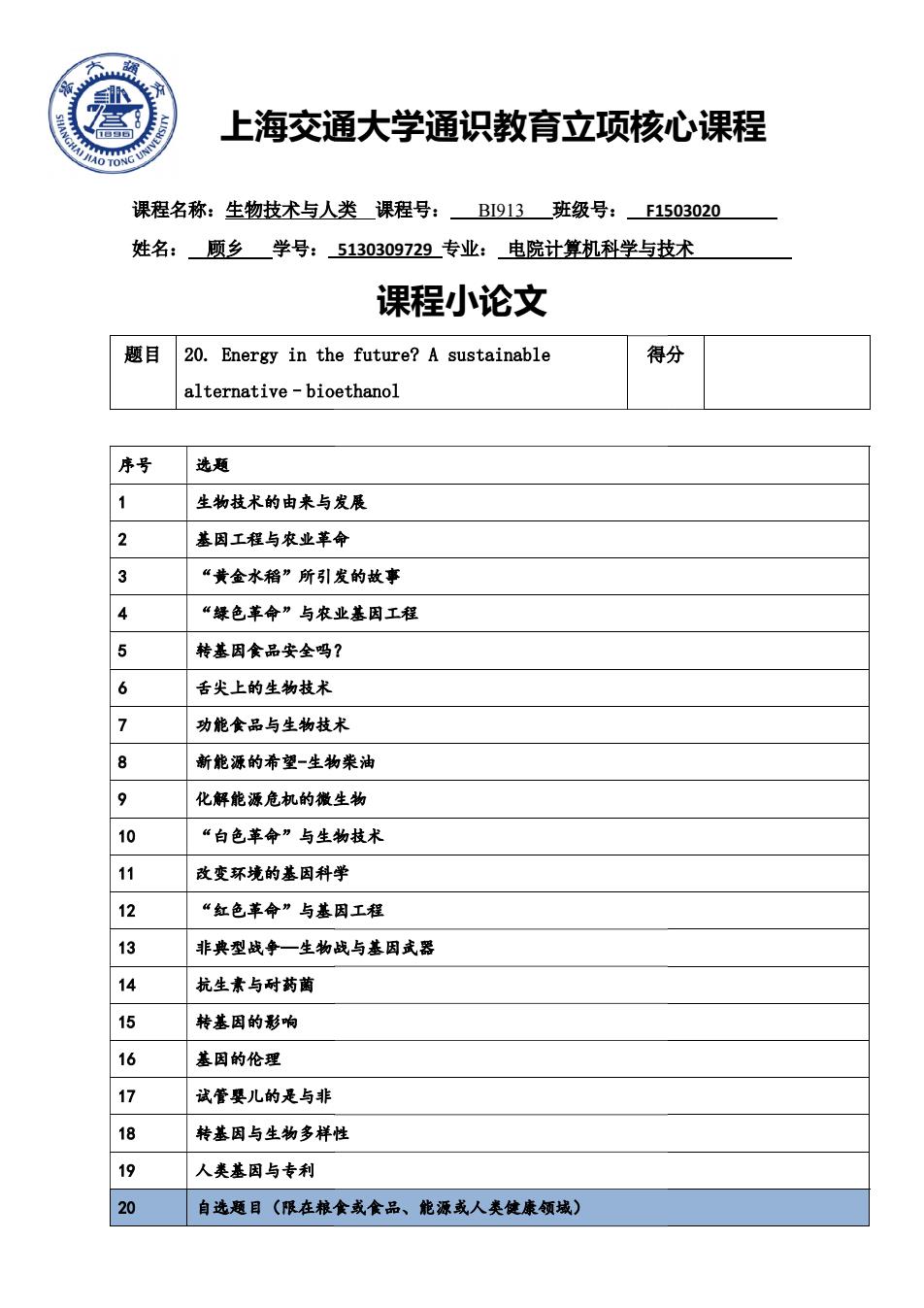
上海交通大学通识教育立项核心课程 课程名称:生物技术与人类课程号:BI913班级号:F1503020 姓名:顾乡学号:5130309729专业:电院计算机科学与技术 课程小论文 题目 20.Energy in the future?A sustainable 得分 alternative-bioethanol 序号 选题 1 生物技术的由来与发展 2 基因工程与农业革命 3 “黄金水稻”所引发的故事 4 “绿色革命”与农业基因工程 5 转基因食品安全吗? 6 舌尖上的生物技术 功能食品与生物技术 8 新能源的希望-生物米油 化解能源危机的微生物 10 “白色革命”与生物技术 11 改变环境的基因科学 12 “红色革命”与基因工程 13 非典型战争一生物战与基因武器 14 抗生素与耐药菌 15 转基因的影响 16 基因的伦理 17 试管要儿的是与非 18 转基因与生物多样性 19 人类基因与专利 20 自选题目(限在粮食或食品、能源或人类使康领域)
上海交通大学通识教育立项核心课程 课程名称:生物技术与人类 姓名: 顾乡 学号: 题目 20. Energy in the future? A sustainable alternative–bioethanol 序号 选题 1 生物技术的由来与发展 2 基因工程与农业革命 3 “黄金水稻”所引发的故事 4 “绿色革命”与农业基因工程 5 转基因食品安全吗? 6 舌尖上的生物技术 7 功能食品与生物技术 8 新能源的希望-生物柴油 9 化解能源危机的微生物 10 “白色革命”与生物技术 11 改变环境的基因科学 12 “红色革命”与基因工程 13 非典型战争—生物战与基因武器 14 抗生素与耐药菌 15 转基因的影响 16 基因的伦理 17 试管婴儿的是与非 18 转基因与生物多样性 19 人类基因与专利 20 自选题目(限在粮食或食品 上海交通大学通识教育立项核心课程 生物技术与人类 课程号: BI913 班级号: F1503020 5130309729 专业: 电院计算机科学与技术 课程小论文 the future? A sustainable bioethanol 得分 生物技术的由来与发展 基因工程与农业革命 所引发的故事 与农业基因工程 ? 功能食品与生物技术 生物柴油 化解能源危机的微生物 与生物技术 改变环境的基因科学 与基因工程 生物战与基因武器 转基因与生物多样性 限在粮食或食品、能源或人类健康领域) 上海交通大学通识教育立项核心课程 F1503020 电院计算机科学与技术 得分
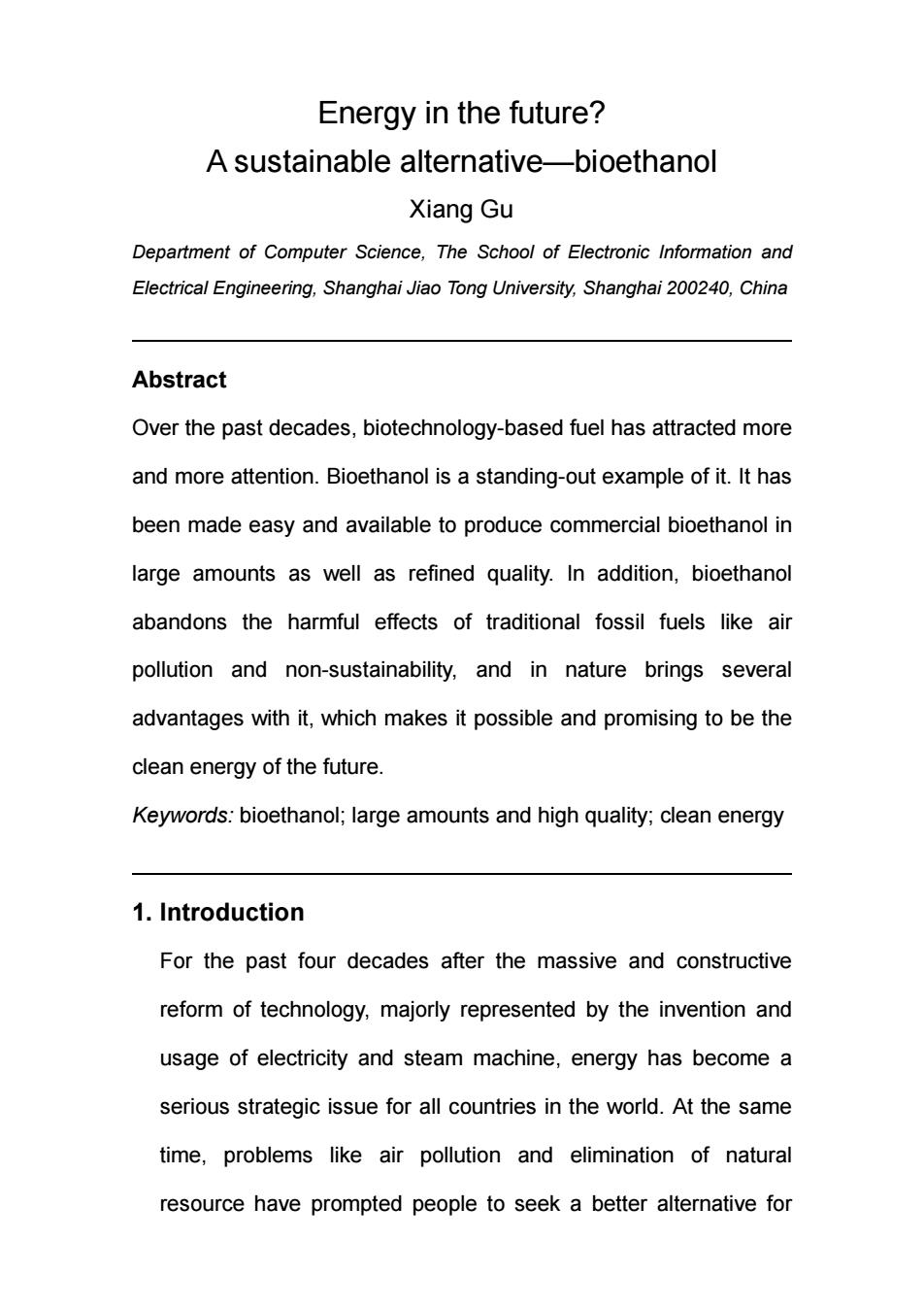
Energy in the future? A sustainable alternative-bioethanol Xiang Gu Department of Computer Science,The School of Electronic Information and Electrical Engineering,Shanghai Jiao Tong University,Shanghai 200240,China Abstract Over the past decades,biotechnology-based fuel has attracted more and more attention.Bioethanol is a standing-out example of it.It has been made easy and available to produce commercial bioethanol in large amounts as well as refined quality.In addition,bioethanol abandons the harmful effects of traditional fossil fuels like air pollution and non-sustainability,and in nature brings several advantages with it,which makes it possible and promising to be the clean energy of the future. Keywords:bioethanol;large amounts and high quality;clean energy 1.Introduction For the past four decades after the massive and constructive reform of technology,majorly represented by the invention and usage of electricity and steam machine,energy has become a serious strategic issue for all countries in the world.At the same time,problems like air pollution and elimination of natural resource have prompted people to seek a better alternative for
Energy in the future? A sustainable alternative—bioethanol Xiang Gu Department of Computer Science, The School of Electronic Information and Electrical Engineering, Shanghai Jiao Tong University, Shanghai 200240, China Abstract Over the past decades, biotechnology-based fuel has attracted more and more attention. Bioethanol is a standing-out example of it. It has been made easy and available to produce commercial bioethanol in large amounts as well as refined quality. In addition, bioethanol abandons the harmful effects of traditional fossil fuels like air pollution and non-sustainability, and in nature brings several advantages with it, which makes it possible and promising to be the clean energy of the future. Keywords: bioethanol; large amounts and high quality; clean energy 1. Introduction For the past four decades after the massive and constructive reform of technology, majorly represented by the invention and usage of electricity and steam machine, energy has become a serious strategic issue for all countries in the world. At the same time, problems like air pollution and elimination of natural resource have prompted people to seek a better alternative for
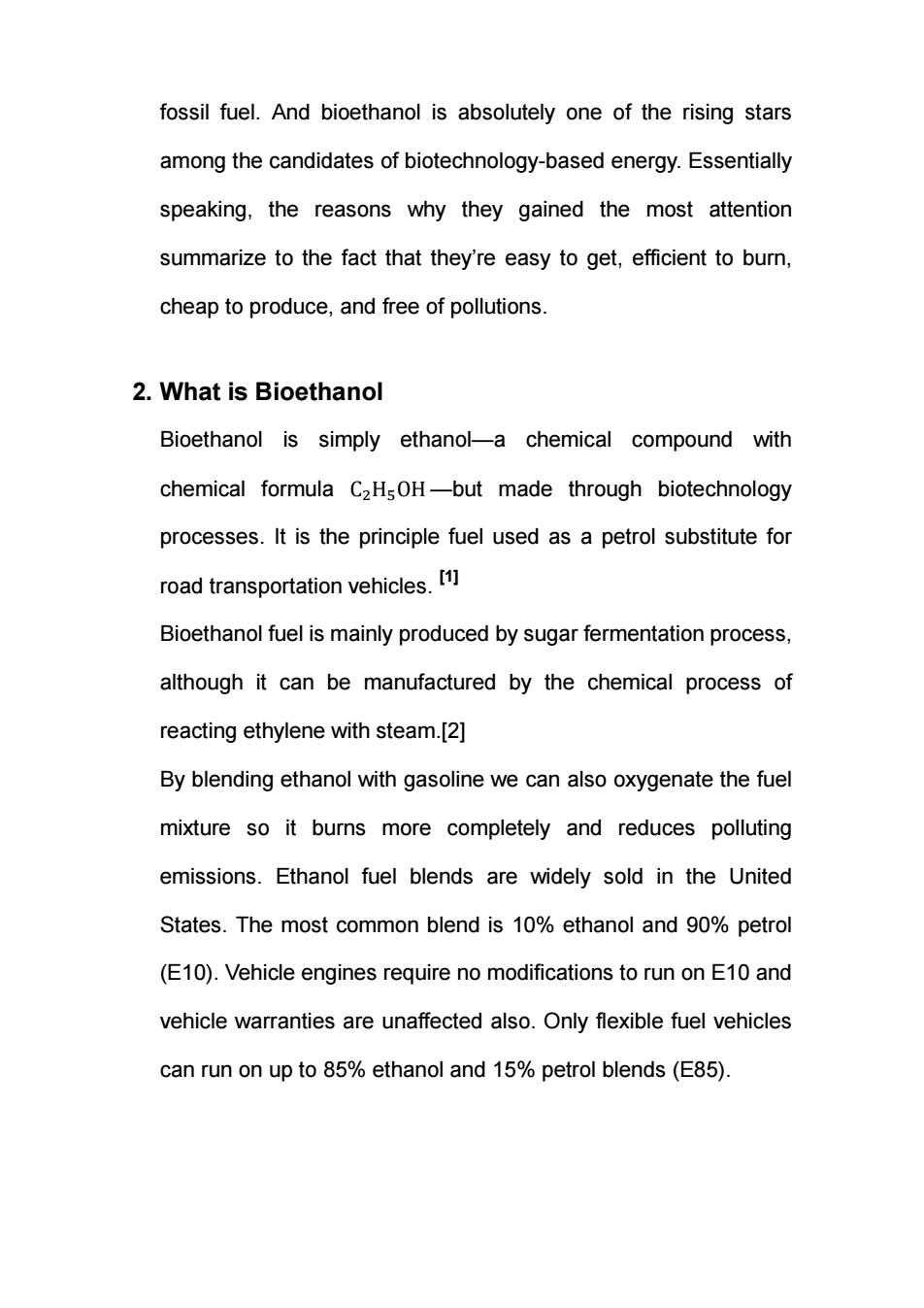
fossil fuel.And bioethanol is absolutely one of the rising stars among the candidates of biotechnology-based energy.Essentially speaking,the reasons why they gained the most attention summarize to the fact that they're easy to get,efficient to burn, cheap to produce,and free of pollutions. 2.What is Bioethanol Bioethanol is simply ethanol-a chemical compound with chemical formula C2HsOH-but made through biotechnology processes.It is the principle fuel used as a petrol substitute for road transportation vehicles.1 Bioethanol fuel is mainly produced by sugar fermentation process, although it can be manufactured by the chemical process of reacting ethylene with steam.[2] By blending ethanol with gasoline we can also oxygenate the fuel mixture so it burns more completely and reduces polluting emissions.Ethanol fuel blends are widely sold in the United States.The most common blend is 10%ethanol and 90%petrol (E10).Vehicle engines require no modifications to run on E10 and vehicle warranties are unaffected also.Only flexible fuel vehicles can run on up to 85%ethanol and 15%petrol blends(E85)
fossil fuel. And bioethanol is absolutely one of the rising stars among the candidates of biotechnology-based energy. Essentially speaking, the reasons why they gained the most attention summarize to the fact that they’re easy to get, efficient to burn, cheap to produce, and free of pollutions. 2. What is Bioethanol Bioethanol is simply ethanol—a chemical compound with chemical formula CଶHହOH —but made through biotechnology processes. It is the principle fuel used as a petrol substitute for road transportation vehicles. [1] Bioethanol fuel is mainly produced by sugar fermentation process, although it can be manufactured by the chemical process of reacting ethylene with steam.[2] By blending ethanol with gasoline we can also oxygenate the fuel mixture so it burns more completely and reduces polluting emissions. Ethanol fuel blends are widely sold in the United States. The most common blend is 10% ethanol and 90% petrol (E10). Vehicle engines require no modifications to run on E10 and vehicle warranties are unaffected also. Only flexible fuel vehicles can run on up to 85% ethanol and 15% petrol blends (E85)
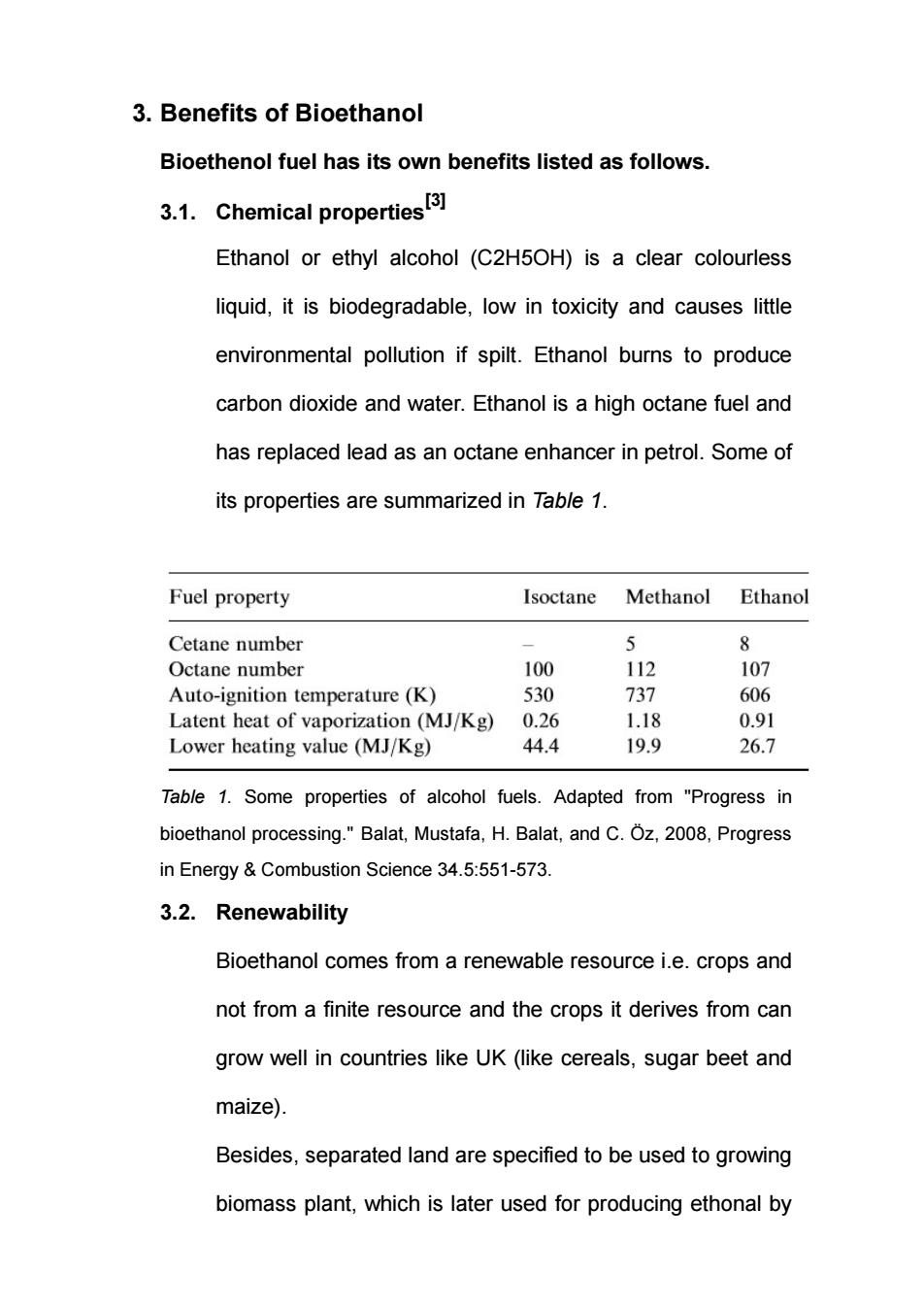
3.Benefits of Bioethanol Bioethenol fuel has its own benefits listed as follows. 3.1.Chemical properties3] Ethanol or ethyl alcohol (C2H5OH)is a clear colourless liquid,it is biodegradable,low in toxicity and causes little environmental pollution if spilt.Ethanol burns to produce carbon dioxide and water.Ethanol is a high octane fuel and has replaced lead as an octane enhancer in petrol.Some of its properties are summarized in Table 1. Fuel property Isoctane Methanol Ethanol Cetane number 5 8 Octane number 100 112 107 Auto-ignition temperature (K) 530 737 606 Latent heat of vaporization (MJ/Kg) 0.26 1.18 0.91 Lower heating value (MJ/Kg) 44.4 19.9 26.7 Table 1.Some properties of alcohol fuels.Adapted from "Progress in bioethanol processing."Balat,Mustafa,H.Balat,and C.Oz,2008,Progress in Energy Combustion Science 34.5:551-573. 3.2.Renewability Bioethanol comes from a renewable resource i.e.crops and not from a finite resource and the crops it derives from can grow well in countries like UK(like cereals,sugar beet and maize). Besides,separated land are specified to be used to growing biomass plant,which is later used for producing ethonal by
3. Benefits of Bioethanol Bioethenol fuel has its own benefits listed as follows. 3.1. Chemical properties[3] Ethanol or ethyl alcohol (C2H5OH) is a clear colourless liquid, it is biodegradable, low in toxicity and causes little environmental pollution if spilt. Ethanol burns to produce carbon dioxide and water. Ethanol is a high octane fuel and has replaced lead as an octane enhancer in petrol. Some of its properties are summarized in Table 1. Table 1. Some properties of alcohol fuels. Adapted from "Progress in bioethanol processing." Balat, Mustafa, H. Balat, and C. Öz, 2008, Progress in Energy & Combustion Science 34.5:551-573. 3.2. Renewability Bioethanol comes from a renewable resource i.e. crops and not from a finite resource and the crops it derives from can grow well in countries like UK (like cereals, sugar beet and maize). Besides, separated land are specified to be used to growing biomass plant, which is later used for producing ethonal by
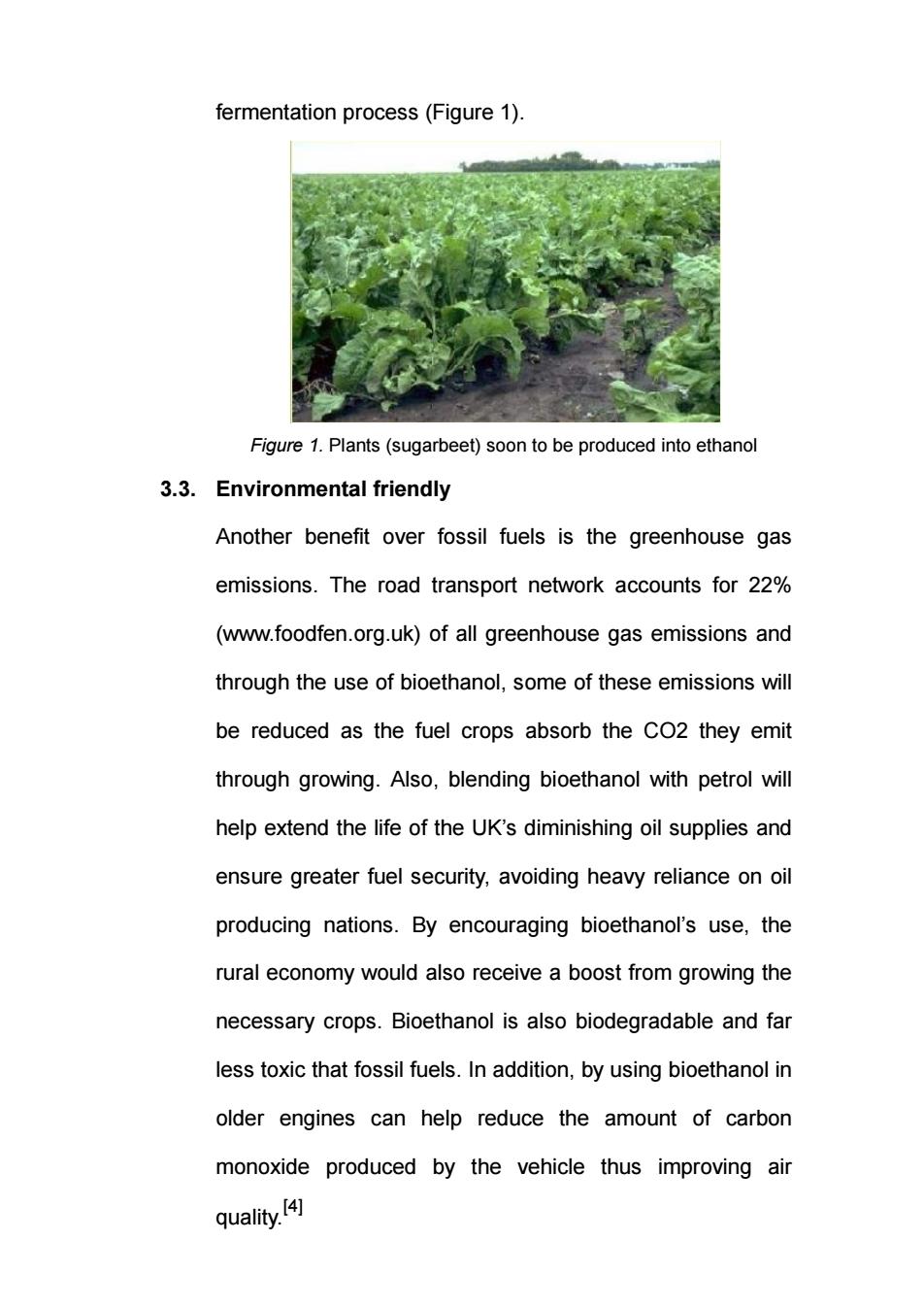
fermentation process(Figure 1). Figure 1.Plants(sugarbeet)soon to be produced into ethanol 3.3.Environmental friendly Another benefit over fossil fuels is the greenhouse gas emissions.The road transport network accounts for 22% (www.foodfen.org.uk)of all greenhouse gas emissions and through the use of bioethanol,some of these emissions will be reduced as the fuel crops absorb the CO2 they emit through growing.Also,blending bioethanol with petrol will help extend the life of the UK's diminishing oil supplies and ensure greater fuel security,avoiding heavy reliance on oil producing nations.By encouraging bioethanol's use,the rural economy would also receive a boost from growing the necessary crops.Bioethanol is also biodegradable and far less toxic that fossil fuels.In addition,by using bioethanol in older engines can help reduce the amount of carbon monoxide produced by the vehicle thus improving air quality,4]
fermentation process (Figure 1). Figure 1. Plants (sugarbeet) soon to be produced into ethanol 3.3. Environmental friendly Another benefit over fossil fuels is the greenhouse gas emissions. The road transport network accounts for 22% (www.foodfen.org.uk) of all greenhouse gas emissions and through the use of bioethanol, some of these emissions will be reduced as the fuel crops absorb the CO2 they emit through growing. Also, blending bioethanol with petrol will help extend the life of the UK’s diminishing oil supplies and ensure greater fuel security, avoiding heavy reliance on oil producing nations. By encouraging bioethanol’s use, the rural economy would also receive a boost from growing the necessary crops. Bioethanol is also biodegradable and far less toxic that fossil fuels. In addition, by using bioethanol in older engines can help reduce the amount of carbon monoxide produced by the vehicle thus improving air quality.[4]

3.4.Ease with integrating into the existing fuel system Another advantage of bioethanol is the ease with which it can be easily integrated into the existing road transport fuel system.In quantities up to 5%,bioethanol can be blended with conventional fuel without the need of engine modifications.Bioethanol is produced using familiar methods,such as fermentation,and it can be distributed using the same petrol forecourts and transportation systems as before5] 4.Trends on Bioethanol 4.1.A general overview[6] Almost every major countries in this world have launched their own program of bioethanol fuel(Table 2). Country Feedstock Percentage of ethanol Remarks in gasoline blends,%(v/v) Brazil Sugar cane 24 ProAlcool program;hydrous ethanol is also used as fuel instead of gasoline USA Corn 10 Oxygenation of gasoline is mandatory in dirtiest cities;tax incentives;some states have banned MTBE:85%blends are also available Canada Corn,wheat,barley 7.510 Tax incentives;provincial programs aimed to meet Kyoto Protocol Colombia Sugar cane 10 Began in November 2005;total tax exemption Spain Wheat,barley Ethanol is used for ETBE production;direct gasoline blending is possible France Sugar beet,wheat,corn Ethanol is used for ETBE production;direct gasoline blending is possible Sweden Wheat 5 85%blends are also available;there is no ETBE production China Corn,wheat Trial use of fuel ethanol in central and north-eastern regions India Sugar cane 5 Ethanol blends are mandatory in 9 states Thailand Cassava,sugar cane,rice 10 All gasoline stations in Bangkok must sell ethanol blends:ethanol blends will be mandatory from 2007 Table 2.Fuel ethonal programs in some countries.Adapted from "Trends in biotechnological production of fuel ethanol from different feedstocks."by Sanchez,Oj,and C.Cardona,2008,Bioresource Technology 99.13:5270. Obviously,bioethanol fuel has attracted a great deal of interests for almost all of the major powers in the world.And
3.4. Ease with integrating into the existing fuel system Another advantage of bioethanol is the ease with which it can be easily integrated into the existing road transport fuel system. In quantities up to 5%, bioethanol can be blended with conventional fuel without the need of engine modifications. Bioethanol is produced using familiar methods, such as fermentation, and it can be distributed using the same petrol forecourts and transportation systems as before.[5] 4. Trends on Bioethanol 4.1. A general overview[6] Almost every major countries in this world have launched their own program of bioethanol fuel (Table 2). Table 2. Fuel ethonal programs in some countries. Adapted from "Trends in biotechnological production of fuel ethanol from different feedstocks." by Sanchez, Oj, and C. Cardona, 2008, Bioresource Technology 99.13:5270. Obviously, bioethanol fuel has attracted a great deal of interests for almost all of the major powers in the world. And

another interesting table (Table 3)relating to the yielding amounts of ethanol fuel also reveals the growing trends of ethonal fuel.Moreover,new technologies have been applied into the process of bioethabol production.In the past,the main and also dominate method of producing bioethanol is through fermentation.And with the help of the advancement of biotechnology,this process becomes more and more reliable, fast,and easy to control.In other word,it is more tractable to human beings now. World production of ethyl alcohol(mill liters) Country 2006 2005 1.USA 18.376 16.139 2.Brazil 16.998 15.999 3.China 3,849 3,800 4.India 1.900 1.699 5.France 950 908 6.Germany 765 431 7.Russia 647 749 8.Canada 579 231 9.Spain 462 352 10.South Africa 386 390 11.Thailand 352 299 12.United Kingdom 280 348 13.Ukraine 269 246 14.Colombia 269 27 15.Poland 250 220 Total 51,056 45.988 Table 3.World production of ethyl alcohol(mill liters).Adapted from"Trends in biotechnological production of fuel ethanol from different feedstocks."by Sanchez,Oj,and C.Cardona,2008,Bioresource Technology 99.13:5270. 4.2.Bioethanol in China Starting from 2001,China has begun its experimental use of bioethanol fuel and its propagation.By the time of 2015,it has reached 11 provinces in China that have been enforced to
another interesting table (Table 3) relating to the yielding amounts of ethanol fuel also reveals the growing trends of ethonal fuel. Moreover, new technologies have been applied into the process of bioethabol production. In the past, the main and also dominate method of producing bioethanol is through fermentation. And with the help of the advancement of biotechnology, this process becomes more and more reliable, fast, and easy to control. In other word, it is more tractable to human beings now. Table 3. World production of ethyl alcohol (mill liters). Adapted from "Trends in biotechnological production of fuel ethanol from different feedstocks." by Sanchez, Oj, and C. Cardona, 2008, Bioresource Technology 99.13:5270. 4.2. Bioethanol in China Starting from 2001, China has begun its experimental use of bioethanol fuel and its propagation. By the time of 2015, it has reached 11 provinces in China that have been enforced to

propagate bioethanol. A breaking-through step happened recently in September, 2017 when the government,together with 15 departments, issued a proposal on boosting the growth of ethanol in China, named "plementation of ethanol gasoline for the expansion of biofuel ethanol production and promotion".It can be envisioned that,in the next two decades,ethanol fueled car will definitely be the optimal choice of vehicles. Yet,many server problem concerning the expanding of bioethanol in China still stood in the way.The biggest problem is the immaturity of car engines.Like electricity-powered cars, ethanol fueled cars rely heavily on the modification of engines so that it can working properly with a mix fuel of high percentage of ethanol.The society also gives rise to the concern of such setbacks that prevents ethanol cars from speedily developing in China. 5.Conclusion Bioethanol is itself a promising energy alternative in the future.A main usage for bioethanol is to serve as a substitute of petrol for road transportation vehicles.Bioethanol has many benefits and yet virtually no obvious setbacks.In addition,more and more countries have given their strategic priority of bioethanol fuels.In China,it still has a long way to go for bioethanol-powered
propagate bioethanol. A breaking-through step happened recently in September, 2017 when the government, together with 15 departments, issued a proposal on boosting the growth of ethanol in China, named “plementation of ethanol gasoline for the expansion of biofuel ethanol production and promotion”. It can be envisioned that, in the next two decades, ethanol fueled car will definitely be the optimal choice of vehicles. Yet, many server problem concerning the expanding of bioethanol in China still stood in the way. The biggest problem is the immaturity of car engines. Like electricity-powered cars, ethanol fueled cars rely heavily on the modification of engines so that it can working properly with a mix fuel of high percentage of ethanol. The society also gives rise to the concern of such setbacks that prevents ethanol cars from speedily developing in China. 5. Conclusion Bioethanol is itself a promising energy alternative in the future. A main usage for bioethanol is to serve as a substitute of petrol for road transportation vehicles. Bioethanol has many benefits and yet virtually no obvious setbacks. In addition, more and more countries have given their strategic priority of bioethanol fuels. In China, it still has a long way to go for bioethanol-powered
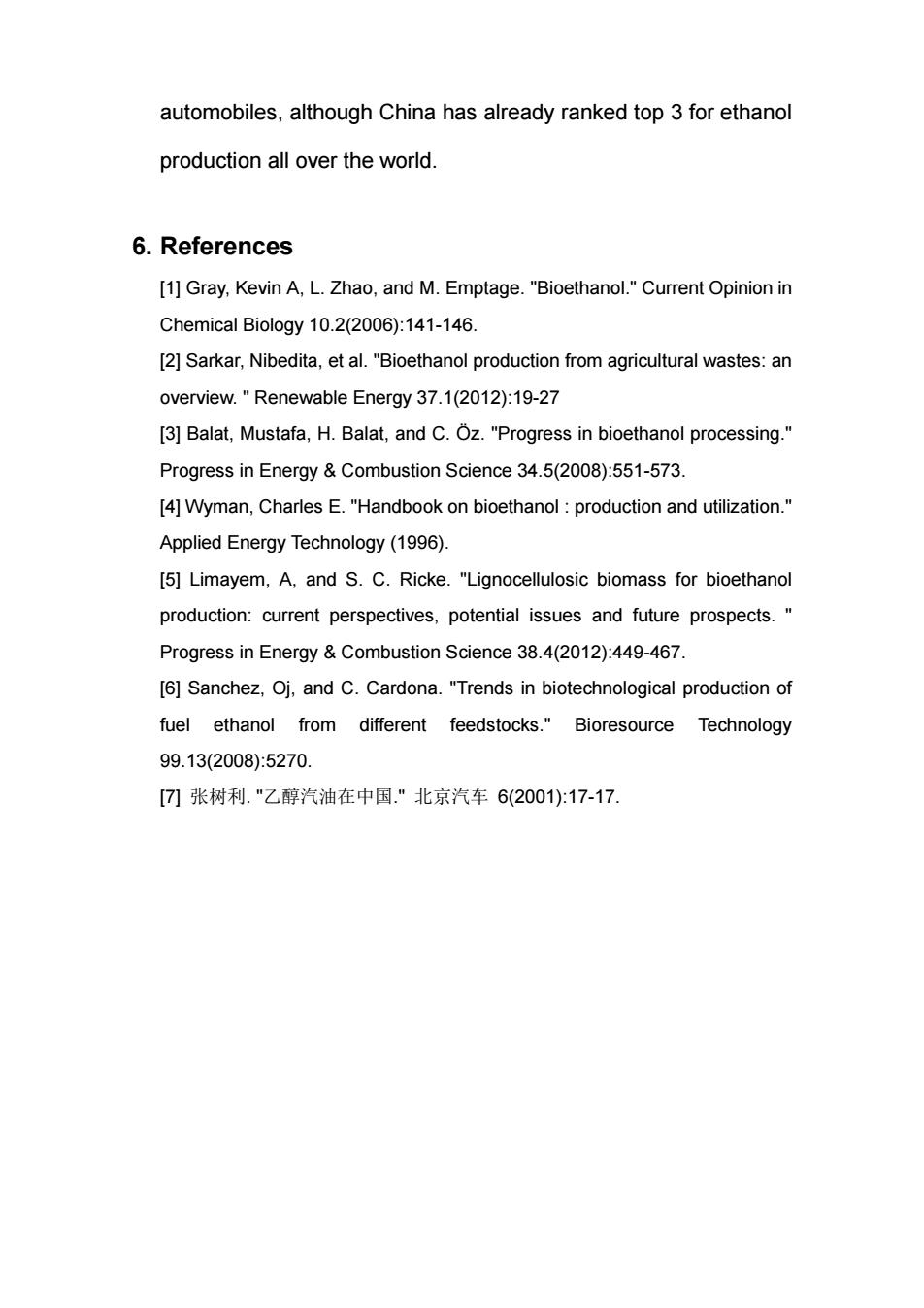
automobiles,although China has already ranked top 3 for ethanol production all over the world. 6.References [1]Gray,Kevin A,L.Zhao,and M.Emptage."Bioethanol."Current Opinion in Chemical Biology 10.2(2006):141-146. [2]Sarkar,Nibedita,et al."Bioethanol production from agricultural wastes:an overview."Renewable Energy 37.1(2012):19-27 [3]Balat,Mustafa,H.Balat,and C.Oz."Progress in bioethanol processing." Progress in Energy Combustion Science 34.5(2008):551-573. [4]Wyman,Charles E."Handbook on bioethanol production and utilization." Applied Energy Technology(1996). [5]Limayem,A,and S.C.Ricke."Lignocellulosic biomass for bioethanol production:current perspectives,potential issues and future prospects. Progress in Energy Combustion Science 38.4(2012):449-467 [6]Sanchez,Oj,and C.Cardona."Trends in biotechnological production of fuel ethanol from different feedstocks."Bioresource Technology 99.13(2008):5270. [7]张树利."乙醇汽油在中国."北京汽车6(2001):17-17
automobiles, although China has already ranked top 3 for ethanol production all over the world. 6. References [1] Gray, Kevin A, L. Zhao, and M. Emptage. "Bioethanol." Current Opinion in Chemical Biology 10.2(2006):141-146. [2] Sarkar, Nibedita, et al. "Bioethanol production from agricultural wastes: an overview. " Renewable Energy 37.1(2012):19-27 [3] Balat, Mustafa, H. Balat, and C. Öz. "Progress in bioethanol processing." Progress in Energy & Combustion Science 34.5(2008):551-573. [4] Wyman, Charles E. "Handbook on bioethanol : production and utilization." Applied Energy Technology (1996). [5] Limayem, A, and S. C. Ricke. "Lignocellulosic biomass for bioethanol production: current perspectives, potential issues and future prospects. " Progress in Energy & Combustion Science 38.4(2012):449-467. [6] Sanchez, Oj, and C. Cardona. "Trends in biotechnological production of fuel ethanol from different feedstocks." Bioresource Technology 99.13(2008):5270. [7] 张树利. "乙醇汽油在中国." 北京汽车 6(2001):17-17